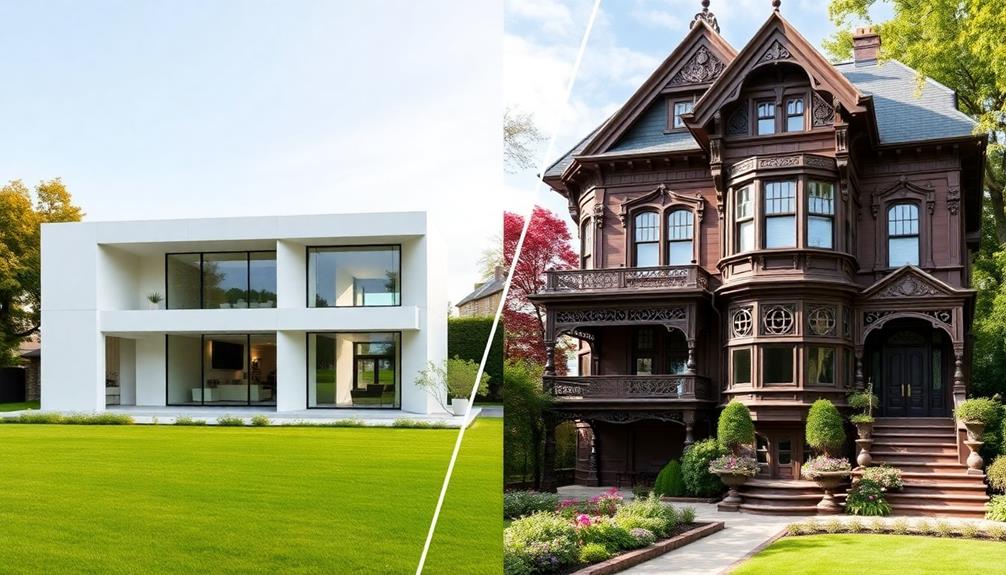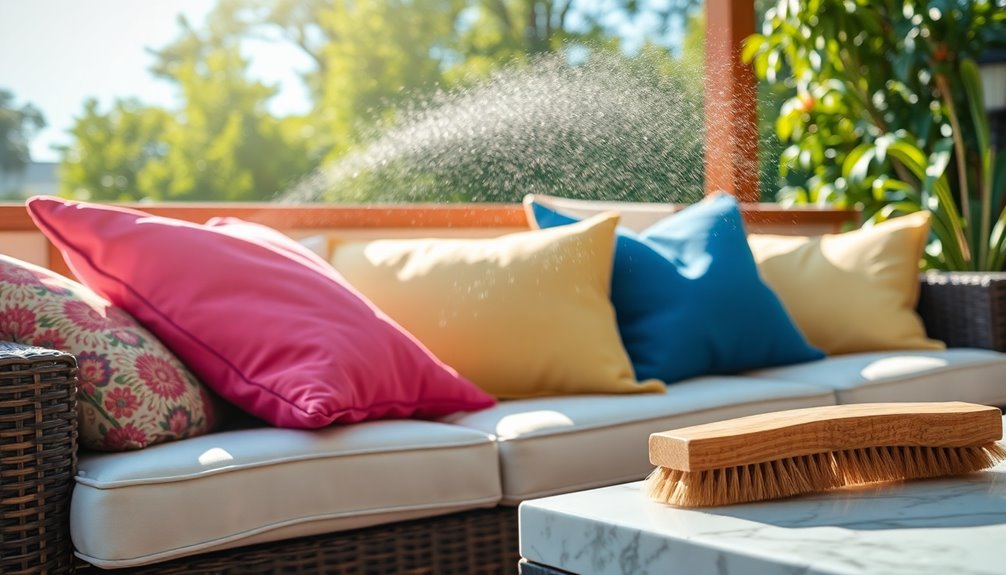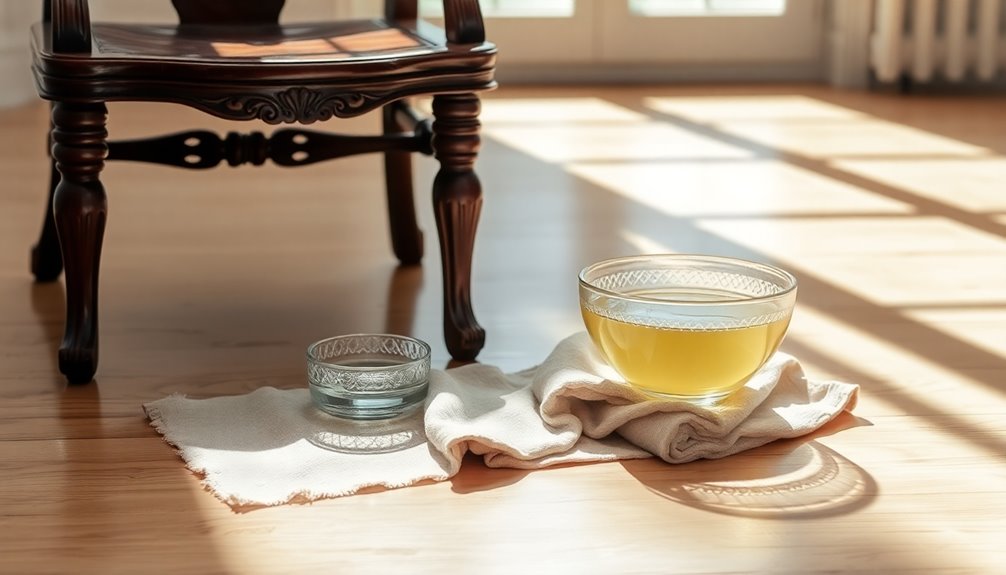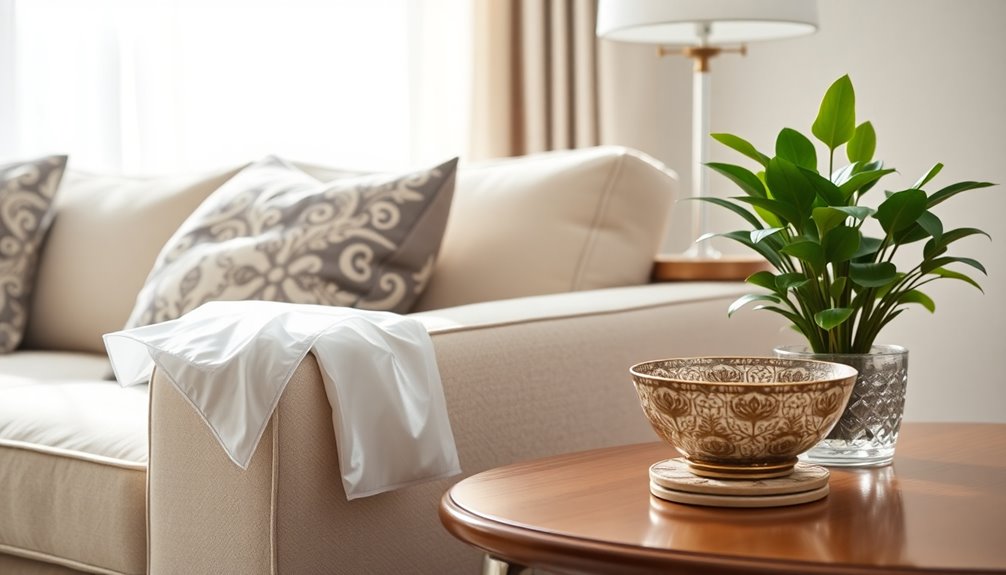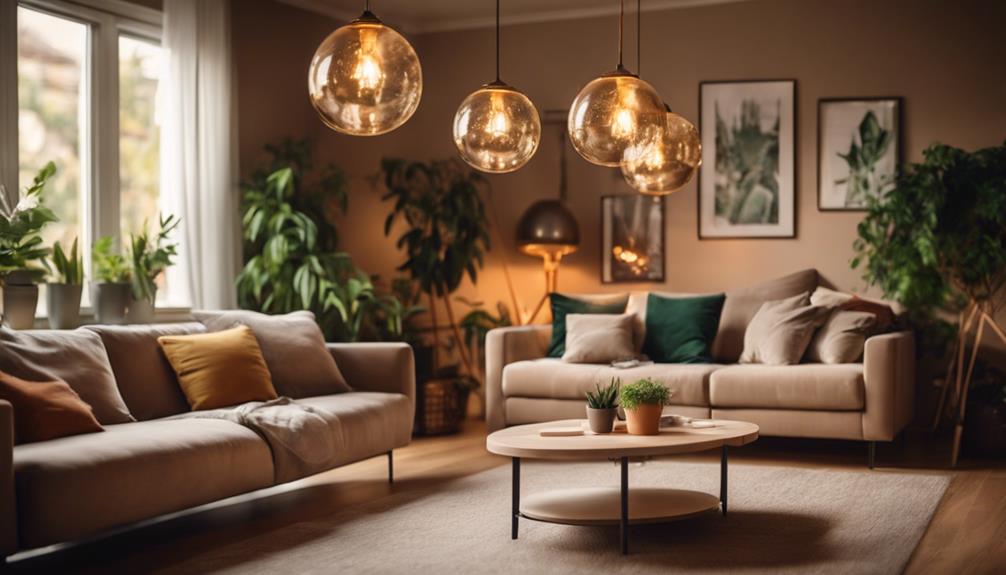When you explore the clash of styles between modern and traditional homes, you'll notice striking differences. Modern designs focus on minimalism and open spaces, featuring large windows and sleek lines. In contrast, traditional homes emphasize elegance with symmetrical layouts and intricate details. Materials play a key role too; modern homes often use steel and glass for durability, while traditional ones rely on warm wood and brick. From color palettes to roof styles, each choice influences the overall feel of a home. There's a lot more to uncover about these contrasting aesthetics, so keep going to discover even more insights.
Key Takeaways
- Modern homes prioritize open-concept spaces and sleek lines, while traditional homes emphasize symmetry and intricate details for elegance.
- Material choices differ significantly; modern designs use steel and glass for durability, whereas traditional styles favor natural materials like wood and stone.
- Color palettes contrast, with traditional homes featuring rich, warm hues and modern designs adopting subdued, monochromatic schemes for a minimalist feel.
- Roof styles also vary; traditional homes often have ornate, sloped roofs, while modern architecture showcases clean, flat roofs for simplicity.
- Each style's unique characteristics influence the overall ambiance, functionality, and aesthetic appeal of the living space.
Architectural Design Variances
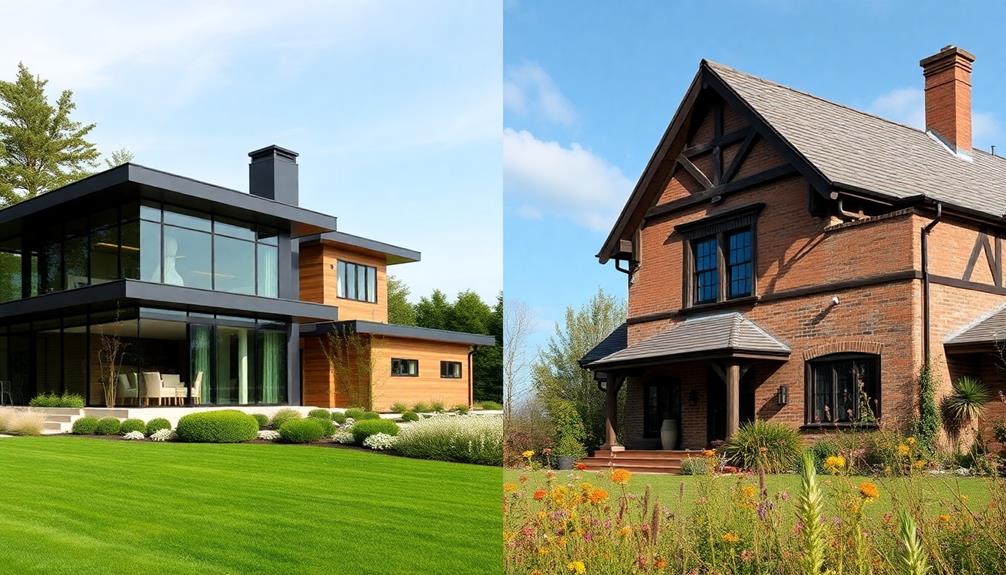
When you explore the architectural design variances between modern and traditional homes, you'll notice distinct approaches that reflect different philosophies.
Modern homes embrace minimalism, featuring open-concept spaces that prioritize functionality and efficiency. You'll see sleek lines, large windows, and a focus on light-filled environments that create a sense of openness.
In contrast, traditional homes showcase elegance through symmetrical layouts and intricate details, emphasizing craftsmanship and historical elements. You might appreciate the ornate moldings, decorative trim, and rich textures that define these classic designs.
Each style conveys a unique story, highlighting the evolution of architecture from timeless appeal to contemporary innovation. Understanding these differences can help you appreciate the charm of both styles in today's diverse architectural landscape.
Material Selection Distinctions
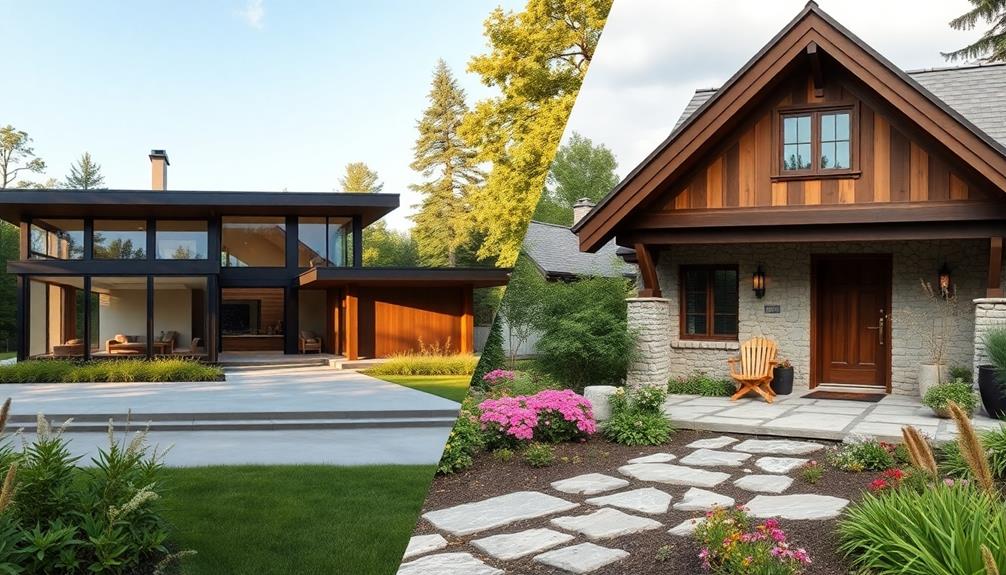
Understanding the architectural differences between modern and traditional homes naturally leads to the importance of material selection.
When you're choosing materials for a modern home, sleek options like steel and glass create a contemporary feel and emphasize minimalism. These materials not only enhance durability but also promote sustainability.
On the other hand, traditional homes rely on natural materials such as wood, stone, and brick, which showcase craftsmanship and historical significance. The warmth and elegance of these materials often reflect a deeper connection to heritage. Modern home construction, on the other hand, often prioritizes efficiency and convenience, using materials such as concrete, steel, and glass. While these materials offer strength and versatility, they may lack the charm and character of traditional materials. However, modern construction techniques and materials also allow for innovative and sustainable designs that can meet the needs of contemporary living.
Ultimately, your material choices profoundly influence the overall style and environmental footprint of your home, making it essential to contemplate how these elements align with your desired aesthetic and values.
Modern Materials Overview
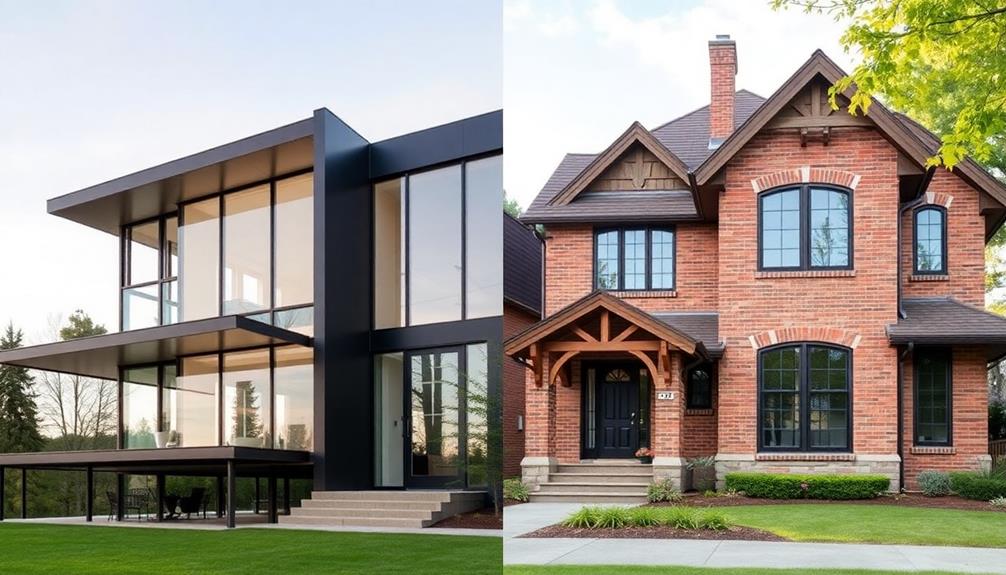
Modern homes thrive on a foundation of innovative materials that redefine contemporary living.
These materials not only enhance aesthetics but also contribute to sustainability and durability.
Here's a quick overview of key modern materials:
- Steel: Offers exceptional strength and an industrial aesthetic.
- Concrete: Chosen for its sustainability and minimalist design appeal.
- Architectural Glass: Fills spaces with natural light, creating an airy atmosphere.
- Composite Materials: Provide versatility and resilience, often mimicking traditional styles without the drawbacks.
These modern materials define the overall ambiance and functionality of your living space, allowing for a balance of style and practicality.
Embracing them means stepping into a world where design meets innovation, ultimately enhancing your modern lifestyle.
Traditional Vs. Contemporary Choices
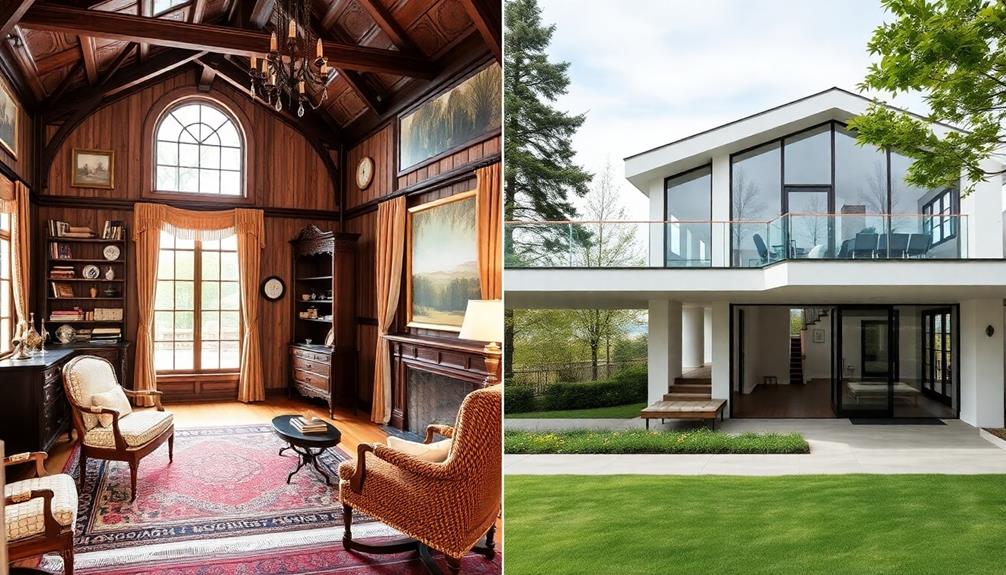
In the world of architecture, the choice between traditional and contemporary styles can set the tone for your entire home. Traditional designs often emphasize natural elements and craftsmanship, while contemporary homes embrace sleek, industrial materials. You might appreciate the ornate finishes and hand-carved woodwork that traditional styles provide. In contrast, contemporary designs favor clean lines and minimalism.
| Traditional Choices | Contemporary Choices |
|---|---|
| Hand-carved woodwork | Steel and glass accents |
| Ornate details | Streamlined aesthetics |
| Symmetrical layouts | Open-concept spaces |
Ultimately, your choice will reflect your personal style and how you want your home to feel. Whether you lean towards the warmth of tradition or the sleekness of modernity, both styles offer unique advantages.
Impact of Material Selection
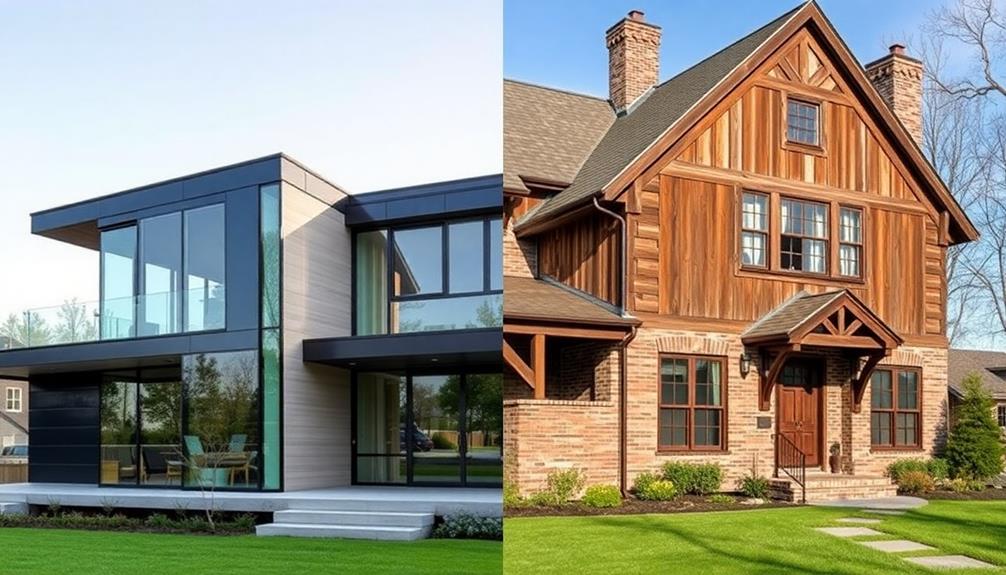
Choosing between traditional and contemporary styles not only influences the overall aesthetic of your home but also impacts the materials you select.
Each choice brings unique qualities that shape your living space. Here's what to take into account:
- Traditional materials like wood and stone offer warmth and craftsmanship.
- Modern materials such as steel and glass provide durability and a sleek look.
- Sustainability plays a role; modern designs often focus on eco-friendly options.
- Character is defined by your material choices, influencing not just style but functionality as well.
Color Palette Variation
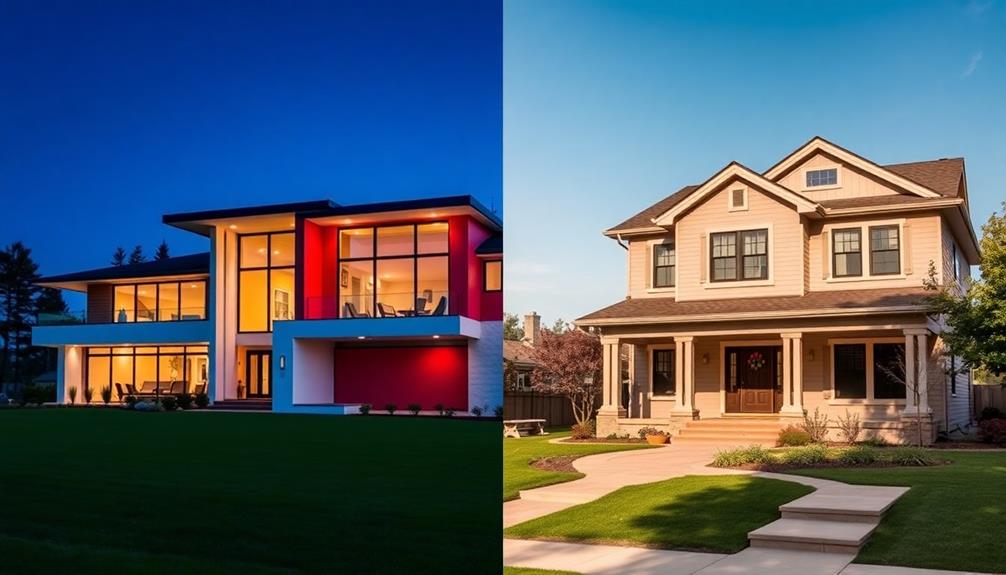
The color palette of your home plays an essential role in defining its character and ambiance. In traditional homes, you'll often find rich hues like burgundy, navy, and olive green, which convey warmth and heritage. These colors create a cozy, inviting atmosphere, complemented by bold accent colors that add vibrancy and richness.
On the other hand, modern homes typically adopt subdued color schemes, favoring whites, greys, and earth tones for a sleek, minimalist look. This monochromatic or tonal approach promotes cohesion, making spaces feel open and airy.
Ultimately, your color choices reflect your personal style—whether you lean toward the elegant complexity of traditional designs or the contemporary simplicity of modern aesthetics.
Roof Styles Contrast
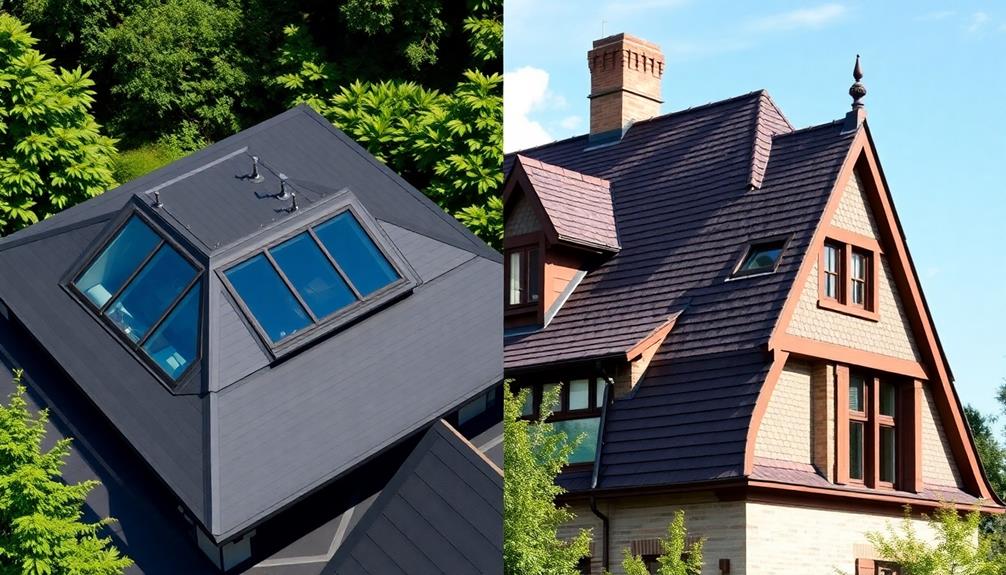
Color choices can set the tone for your home, but roof styles play an equally significant role in defining its overall character.
When considering roof styles, you'll notice distinct contrasts between modern and traditional homes that reflect their unique architectural philosophies.
- Traditional homes often feature charming sloped roofs with intricate details.
- Modern designs showcase sleek flat roofs emphasizing simplicity and efficiency.
- Ornate roofing elements add character to traditional styles, while modern roofs prioritize clean lines.
- The choice of roof style can enhance the overall aesthetic, influencing both function and visual appeal.
Frequently Asked Questions
How Do Energy Efficiency Ratings Differ Between Modern and Traditional Homes?
Energy efficiency ratings vary considerably. Modern homes typically utilize advanced insulation and energy-efficient systems, boosting their ratings, while traditional homes often lack these features, resulting in lower efficiency. You'll notice the difference in energy consumption and comfort.
What Are the Maintenance Requirements for Modern Versus Traditional Homes?
When considering maintenance, modern homes typically require less upkeep due to durable materials and simpler designs. Traditional homes, however, often need more frequent care because of their intricate details and natural materials.
How Do Resale Values Compare Between Modern and Traditional Styles?
Isn't it ironic? You'd think modern homes always fetch higher resale values, but traditional styles often hold their worth better. Ultimately, location and buyer preference play essential roles in determining resale potential for both styles.
Can Modern Homes Incorporate Traditional Elements Successfully?
Yes, you can successfully incorporate traditional elements into modern homes. By blending historical details with contemporary design, you create a unique aesthetic that honors the past while embracing the present, enhancing both beauty and character.
What Are the Typical Costs Associated With Building Each Style?
When building a home, you'll typically find modern designs can cost around $200 per square foot, while traditional homes might reach $250. It's crucial to budget based on materials and craftsmanship required for each style.
Conclusion
As you stand at the crossroads of modern and traditional design, you can feel the tension in the air. Each style whispers promises of unique comforts and aesthetics, begging for your attention. Will you embrace the sleek sophistication of modern lines, or lose yourself in the rich stories woven into every corner of a traditional home? The choice is yours, but as you ponder, imagine the life that could unfold within those walls—each decision shaping your own narrative.
